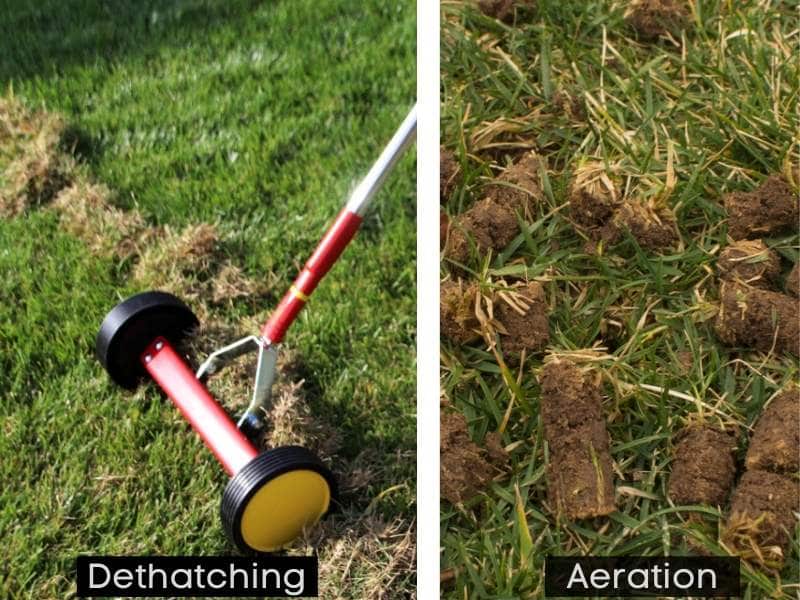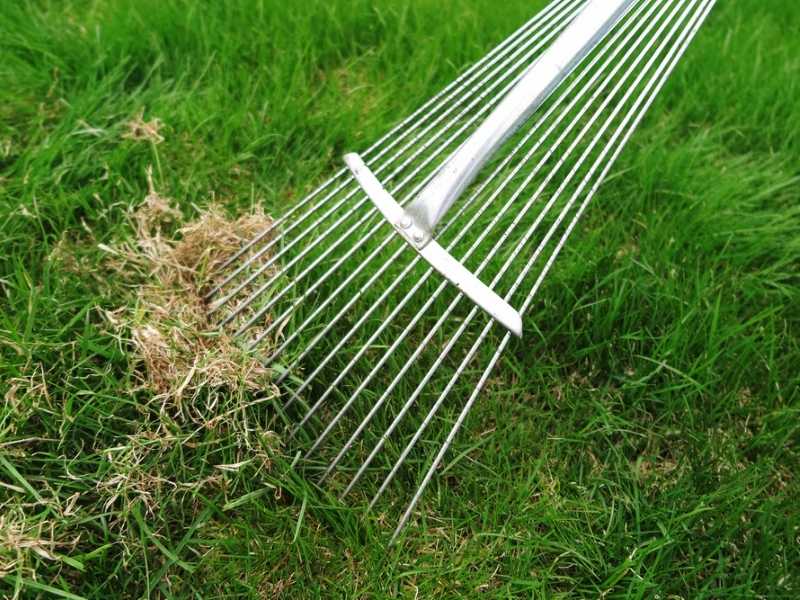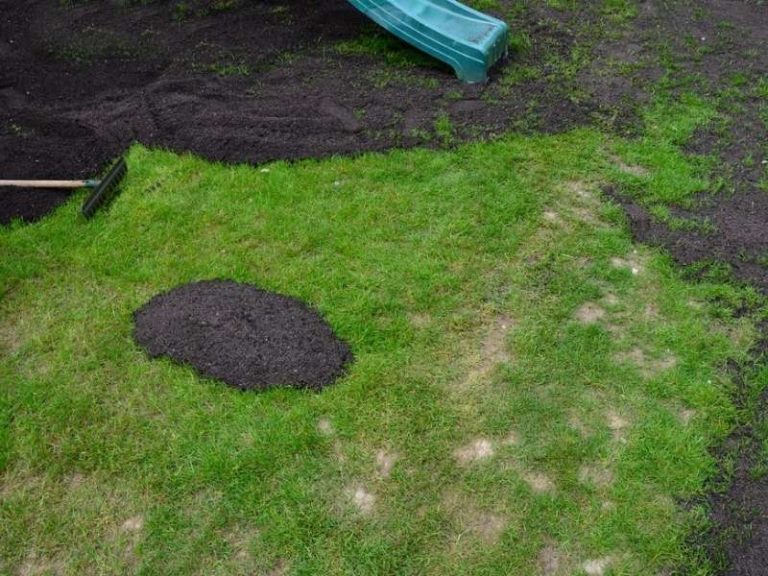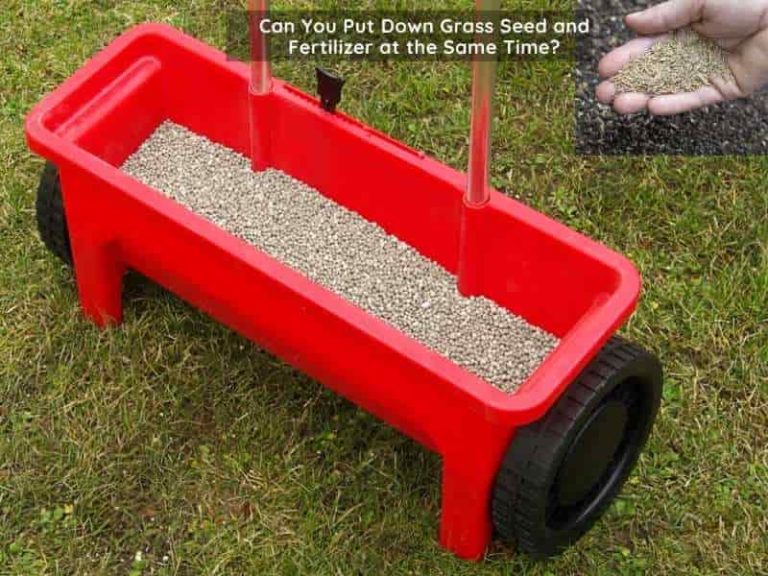Dethatching Vs. Aerating: Differences + Which is Better
Dethatching and aerating are lawn care practices that help improve lawn health and lush appearance. Both of these processes present similar benefits for your turfgrass: increased access to essential nutrients, air, and water to the root systems. But is dethatching and aerating the same? Which is better, to dethatch or aerate the lawn?
Dethatching is done through a power rake with a set of metal times to help remove a layer of dead grass that accumulates on top, leading to poor growth and susceptibility to pests and diseases. On the other hand, aerators carry aeration to make small holes through hollow tines that remove small soil plugs to allow air, water, and nutrients to reach the grass roots more easily.
Dethatching is best done when your lawn has poor growth and is prone to pests and diseases, while Aerating is helpful when you have soil compaction and need to promote root growth. It’s possible to perform both practices for a healthier, greener, and more resilient lawn.
Here are the differences between dethatching and aeration, which should be undertaken before the other, and the most appropriate time to dethatch or aerate your lawn.
Should I aerate or dethatch first?

While both activities serve the same purposes of improving air, nutrients, and water intake into the soil, lawn aeration is best done after dethatching the lawn first. Dethatching first will eliminate layers of dead grass and extra organic matter to facilitate root anchorage, such that by the time you’re aerating, the nutrients and air coming in will be effectively absorbed by the developed root systems.
If your lawn grass suffers from excessive thatches and soil compaction, you can decide to dethatch and aerate simultaneously. In fact, some landscaping brands now manufacture an aerator/dethatcher combo for such purposes.
What is the difference between dethatching and aerating?
Dethatching removes extra thatch from the lawn surface to allow for better air circulation and water flow into the soil. Thatch refers to the decomposing organic matter on the surface of your lawn and may include fallen leaves, left-behind grass clippings, and leaves, twigs, and blossoms from surrounding trees and shrubs.
In moderate amounts, thatch is usually beneficial to the soil; as it feeds it with nutrients while also helping preserve soil moisture- especially during hot summer days. However, excessive thatching can be detrimental to the health of your lawn soil, as the thick layer of thatch causes root suffocation of your turfgrass by preventing air and water from reaching the soil beneath.
Aeration- on the other hand- refers to the process of correcting soil compaction by loosening the soil. Very compact soil is typically hard and can easily stifle root development. The aeration process, which entails the removal of small sections of soil, reverses the effects of compaction by making the soil more breathable. Aerating the soil will allow for faster root development and enable your turfgrass to thrive.
The table below shows some of the additional differences between the dethatching and aeration processes of lawn maintenance:
| Dethatching | Aeration |
| Typically undertaken using a machine called a dethatcher that works to remove the upper-most layer of decomposing organic matter on the surface of your lawn. The power rake tool uses a set of metal tines to remove thatches. | Typically undertaken using a lawn aerator that relieves soil compaction by boring holes into the soil for improved breathability. The aerator tool uses hollow tines to remove small plugs of soil from the ground to relieve soil compaction. |
| Typically undertaken before overseeding to loosen up topsoil. | It can be undertaken before or after overseeding. |
| During the dethatching process, you run the risk of ruining parts of your healthy lawn grass. | The aeration process aids thatch decomposition by opening up the soil for microbes to come in and speed up decomposition. |
What is better for lawn dethatching or aerating?
The answer to this depends on the specific soil conditions in your lawn. For instance, a lawn with good-quality, well-draining soil that doesn’t withstand excessive use/foot traffic will most likely benefit more from dethatching and not aeration. However, some could still argue that aeration is better, given the fact that dethatching pros and cons have the possibility of damaging desirable turfgrass, while aeration has no such disadvantages while still bringing the added advantage of increased microbial activity to help with thatch decomposition.
Things to consider when choosing which is better for a lawn to dethatch or aerate……?
- Dethatch lawn if it has a thick layer of thatch (thicker than 1/2 inch), and aerate when your lawn suffers from soil compaction. Soil compaction may occur due to heavy foot traffic, heavy clay soils, and lack of channeling and burrowing by earthworms.
- Dethatch only when the grass is actively growing, typically in the spring or fall, and aerate any time of year when the ground is wet but should be avoided when frozen and soil too dry.
Note: Your lawn may require you to dethatch and aerate. First assess your lawn to understand the main problems and needs for better planning. However, over-dethatching and over-aerating can be problematic, so follow the guidelines to dethatch and aerate your lawn correctly depending on soil type in your lawn.
Should you dethatch or aerate before overseeding?
For better grass-to-soil contact that allows for faster germination, you should consider dethatching and aerating your lawn before overseeding. In most cases, however, only dethatching will be necessary before overseeding. Core aeration before overseeding is best reserved for lawns with soil compaction issues. It’s also a good time to kill weeds before overseeding your lawn.
When should you dethatch your lawn?

- Before overseeding- dethatching facilitates improved grass seed-soil contact for proper germination during overseeding.
- Before fertilizer application- dethatching allows for improved penetration of fertilizer nutrients into the soil.
- When there’s too much organic debris- when the layer of thatch becomes excessively thick, you should lightly dethatch to improve air circulation and absorption of oxygen for improved grass health.
- When landscaping, dethatching can also be undertaken as part of your landscape maintenance routine, as dead, fallen leaves often give the visual perception of unsightly, dead grass. Dethatching, in such instances, helps restore your lawn’s lush green appearance.
When should you aerate your lawn?
- If you have compacted lawn soil- you can tell if your lawn has compaction issues by observing the frequency of obvious stressors such as high foot traffic and heavy lawn maintenance equipment such as drive-along mowers. The type of soil in your geographical region can also be prone to compaction; for instance, heavy clay soil typically needs to be aerated at least once per year to relieve compaction.
- You can easily test your soil for compaction using the ‘screwdriver test’ whereby you run a screwdriver into the soil to check the resistance level. Too much resistance means the soil has hardened due to compaction, and aeration is necessary.
- Aeration is also best done when turfgrass reaches its natural peak growth season. This is typically around late spring for warm-season turfgrass varieties. On the other hand, cool-season grasses benefit from aeration in early fall.
- Undertaking aeration is also recommended after light showers because slightly moist soil is the easiest to aerate. If you’re looking to aerate your lawn after a heavy downpour, at least wait until most of the water dries up and your lawn is only slightly moist before pulling out plugs of soil from your lawn.




